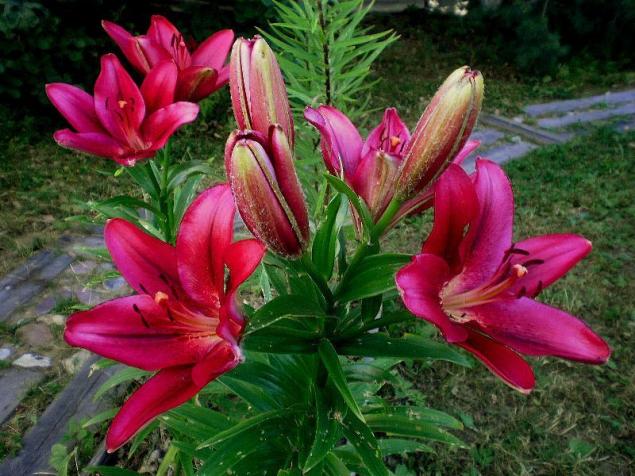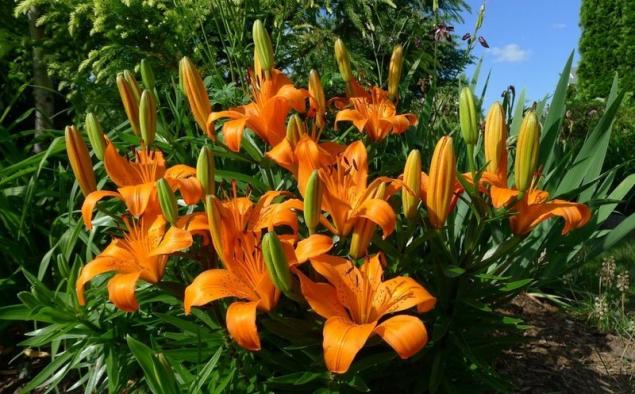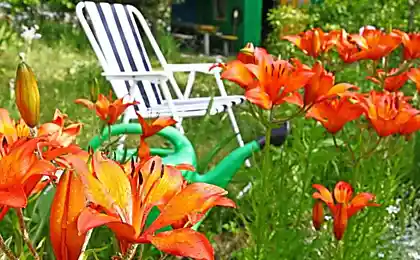477
Features of cultivation of garden lilies and care for them
Noble Lily, for several years pleasing lush color, can be found at many garden sites. Many gardeners claim that it is unpretentious and almost without care every year in the abundance of releases the arrow, unfolding spectacular large flowers. Just take attempts to grow lilies in the garden, you know that behind the apparent simplicity hides hard work. Lily — the Queen of the garden, attention to itself it requires proper.

International classification of the species as a whole list of names for this garden plant has more than 6 thousand species, divided into 100 hybrid groups. The main varieties are:
For the eighth group has its own classification, and study it, preferably before the envelope with the bulb already acquired: the correct interpretation of the marking will not be mistaken with a choice of varieties.
Hybrid types of garden lilies:

Shape of flowers Lily
The main type of flower celebrates one of the eight Roman numerals. Letter will help to introduce the final type of bowl: it is aesthetically pleasing to plan of the future flower beds. The mark on the type of Bud a specific sort of look like Latin letters, written with a slash, after the designation of the main group. The first of these dictates the direction of Bud:
Growing garden lilies in the middle lane

Tiger Lily — the basis of many Asian varieties
In the middle lane care ha thermophilic flower especially laborious. First and foremost is the choice of the varieties: not all of the amenities offered in the sale of varieties able to flourish in a difficult climate. Experienced gardeners recommend to pay attention to the Asian varieties or hybrids based on them, as their progenitor was a tiger Lily, in the wild growing in quite cold areas. The choice of little gardener limited: even this group has more than 150 individual varieties, including vivid examples from large bowls and modest delicate varieties of white lilies. This subspecies is able to actively grow and bloom in any soil except limestone. In any case, the care of the lilies in the garden a difficult plant demanding, and the sun, and moisture, and soil type, therefore, a place for flower beds with Lily should choose carefully.
The choice of location for beds Insistence to the sun depends on the variety: Asian, Oriental and tubular varieties love the sun, but this is only the top part of the plant. Basal area in need of shade. That is why gardeners are rarely planted lilies garden separately. The optimum tandem — dense greens, shading the lower part of the plant, and the lilies themselves, opening domes sunlight. This bed two months will delight with spectacular natural views.
Turk's cap Lily likes partial shade: the favorite area areas along the main walls and fences, where most of the time is saved twilight. The wind does not like either one of the varieties, so on hills the Lily beds are not organized.
Optimal for lilies of the soil — weakly alkaline with the addition of potash just before planting and throughout the season. Of extra power recommended Mel and ash.
Planting bulbs, the Depth of loosening soil before planting lilies should be significant: despite the fact that the bulb is small, its roots can go on down and outwards to a distance of half a meter. This volume of soil needs to be enriched. Clay soil perfectly loose adding of sand, enriched with peat. A few handfuls of mineral fertilizers, added at digging, eliminates the need to feed the plants during the season.
Planted the bulbs in late summer or early fall, a warm September is optimal. Spring planting is also possible, in this case it will be may. The question how to care for lilies in the garden in the winter after planting, the concern of many gardeners. Experts soothe: well-wrapped in twigs and foliage fresh flowerbed survive the cold even better than the Mature plant.
Planting depth of the bulb 10-20 cm For the bulbs with a sufficiently long escape groove is done and the plant is placed with a slope. Before planting the bulbs required manganese bath for 30 minutes: 5 g in a bucket of water. A handful of sand thrown at the bottom of the wells will act as cushion for the roots. Lilies are planted in small groups of 2-3 plants no more than 3 groups per square meter.
Care for lilies Florist will have to work hard to on his site started off large and elegant garden of lilies: planting and care — this is not the end of trouble on the improvement of the Lily beds. Succulent stems require a large amount of water: watering during hot days should become a nightly activity. To get to the leaves when watering not to green-sensitive burns. Necessary weeding and constant cultivation: the land around Lily bushes must be clean. Mulching will allow less water.
Reproduction 2-3 years of good care in the basal area of the stems appear miniature bulbs. With delicate branch and transplant they are able for 2-3 years to blossom independently. Seating scales — method is less reliable: in a separate region not always give shoot even with careful care. Cutting out the scales, it is important to remember the mother plant: the cut carefully prizhivaetsya potassium permanganate or smeared gruel of ash. Themselves scales for germination are planted per hole at a depth of 5-6 cm, sand cushion, as in the case of the landing of conventional bulbs required.
Rules transplant impoverishment of the soil under the Lily bushes observed 5-6 years after planting. Further fertilizing without a transplant does not make sense. Optimum time — the ultimate flowering, when the plant no longer needs power to maintain the buds. Remote plants with greens cut down to a stump in the 5-10 cm fork dug, freed from the earth and slightly dried. Excessively long roots are shortened, and the remaining are rinsed in a solution of manganese 1%, then the plant is carefully placed in pre-moistened soil at the new location.
Planting and transplanting lilies
With proper care, Lily will long delight, and in the flower bed, and the bouquet. In the second case, to preserve the freshness of the bouquet before placing in a vase of cut places experts advise scalded with boiling water. Vase with glycerin gives a truly magical effect: - impregnated composition of the leaves and buds look alive for several years, keeping the original beauty.published
P. S. And remember, only by changing their consumption — together we change the world! ©
Source: 101dizain.ru

International classification of the species as a whole list of names for this garden plant has more than 6 thousand species, divided into 100 hybrid groups. The main varieties are:
- American;
- Asian;
- dlinnozvennye;
- white;
- tubular;
- Turk's cap;
- East;
- hybrid, that is obtained by crossing the previous versions.
For the eighth group has its own classification, and study it, preferably before the envelope with the bulb already acquired: the correct interpretation of the marking will not be mistaken with a choice of varieties.
Hybrid types of garden lilies:
- LA dlinnozvennye with Asian;
- FROM the East to the tubular;
- OA — Asian with East;
- OL — dlinnozvennye Asian

Shape of flowers Lily
The main type of flower celebrates one of the eight Roman numerals. Letter will help to introduce the final type of bowl: it is aesthetically pleasing to plan of the future flower beds. The mark on the type of Bud a specific sort of look like Latin letters, written with a slash, after the designation of the main group. The first of these dictates the direction of Bud:
- up — a;
- in the direction — b;
- down, that is drooping bell — c.
- tubular — a;
- cupped — b;
- flat — c;
- chalmovidnaya — d.
Growing garden lilies in the middle lane

Tiger Lily — the basis of many Asian varieties
In the middle lane care ha thermophilic flower especially laborious. First and foremost is the choice of the varieties: not all of the amenities offered in the sale of varieties able to flourish in a difficult climate. Experienced gardeners recommend to pay attention to the Asian varieties or hybrids based on them, as their progenitor was a tiger Lily, in the wild growing in quite cold areas. The choice of little gardener limited: even this group has more than 150 individual varieties, including vivid examples from large bowls and modest delicate varieties of white lilies. This subspecies is able to actively grow and bloom in any soil except limestone. In any case, the care of the lilies in the garden a difficult plant demanding, and the sun, and moisture, and soil type, therefore, a place for flower beds with Lily should choose carefully.
The choice of location for beds Insistence to the sun depends on the variety: Asian, Oriental and tubular varieties love the sun, but this is only the top part of the plant. Basal area in need of shade. That is why gardeners are rarely planted lilies garden separately. The optimum tandem — dense greens, shading the lower part of the plant, and the lilies themselves, opening domes sunlight. This bed two months will delight with spectacular natural views.
Turk's cap Lily likes partial shade: the favorite area areas along the main walls and fences, where most of the time is saved twilight. The wind does not like either one of the varieties, so on hills the Lily beds are not organized.
Optimal for lilies of the soil — weakly alkaline with the addition of potash just before planting and throughout the season. Of extra power recommended Mel and ash.
Planting bulbs, the Depth of loosening soil before planting lilies should be significant: despite the fact that the bulb is small, its roots can go on down and outwards to a distance of half a meter. This volume of soil needs to be enriched. Clay soil perfectly loose adding of sand, enriched with peat. A few handfuls of mineral fertilizers, added at digging, eliminates the need to feed the plants during the season.
Planted the bulbs in late summer or early fall, a warm September is optimal. Spring planting is also possible, in this case it will be may. The question how to care for lilies in the garden in the winter after planting, the concern of many gardeners. Experts soothe: well-wrapped in twigs and foliage fresh flowerbed survive the cold even better than the Mature plant.
Planting depth of the bulb 10-20 cm For the bulbs with a sufficiently long escape groove is done and the plant is placed with a slope. Before planting the bulbs required manganese bath for 30 minutes: 5 g in a bucket of water. A handful of sand thrown at the bottom of the wells will act as cushion for the roots. Lilies are planted in small groups of 2-3 plants no more than 3 groups per square meter.
Care for lilies Florist will have to work hard to on his site started off large and elegant garden of lilies: planting and care — this is not the end of trouble on the improvement of the Lily beds. Succulent stems require a large amount of water: watering during hot days should become a nightly activity. To get to the leaves when watering not to green-sensitive burns. Necessary weeding and constant cultivation: the land around Lily bushes must be clean. Mulching will allow less water.
Reproduction 2-3 years of good care in the basal area of the stems appear miniature bulbs. With delicate branch and transplant they are able for 2-3 years to blossom independently. Seating scales — method is less reliable: in a separate region not always give shoot even with careful care. Cutting out the scales, it is important to remember the mother plant: the cut carefully prizhivaetsya potassium permanganate or smeared gruel of ash. Themselves scales for germination are planted per hole at a depth of 5-6 cm, sand cushion, as in the case of the landing of conventional bulbs required.
Rules transplant impoverishment of the soil under the Lily bushes observed 5-6 years after planting. Further fertilizing without a transplant does not make sense. Optimum time — the ultimate flowering, when the plant no longer needs power to maintain the buds. Remote plants with greens cut down to a stump in the 5-10 cm fork dug, freed from the earth and slightly dried. Excessively long roots are shortened, and the remaining are rinsed in a solution of manganese 1%, then the plant is carefully placed in pre-moistened soil at the new location.
Planting and transplanting lilies
With proper care, Lily will long delight, and in the flower bed, and the bouquet. In the second case, to preserve the freshness of the bouquet before placing in a vase of cut places experts advise scalded with boiling water. Vase with glycerin gives a truly magical effect: - impregnated composition of the leaves and buds look alive for several years, keeping the original beauty.published
P. S. And remember, only by changing their consumption — together we change the world! ©
Source: 101dizain.ru























